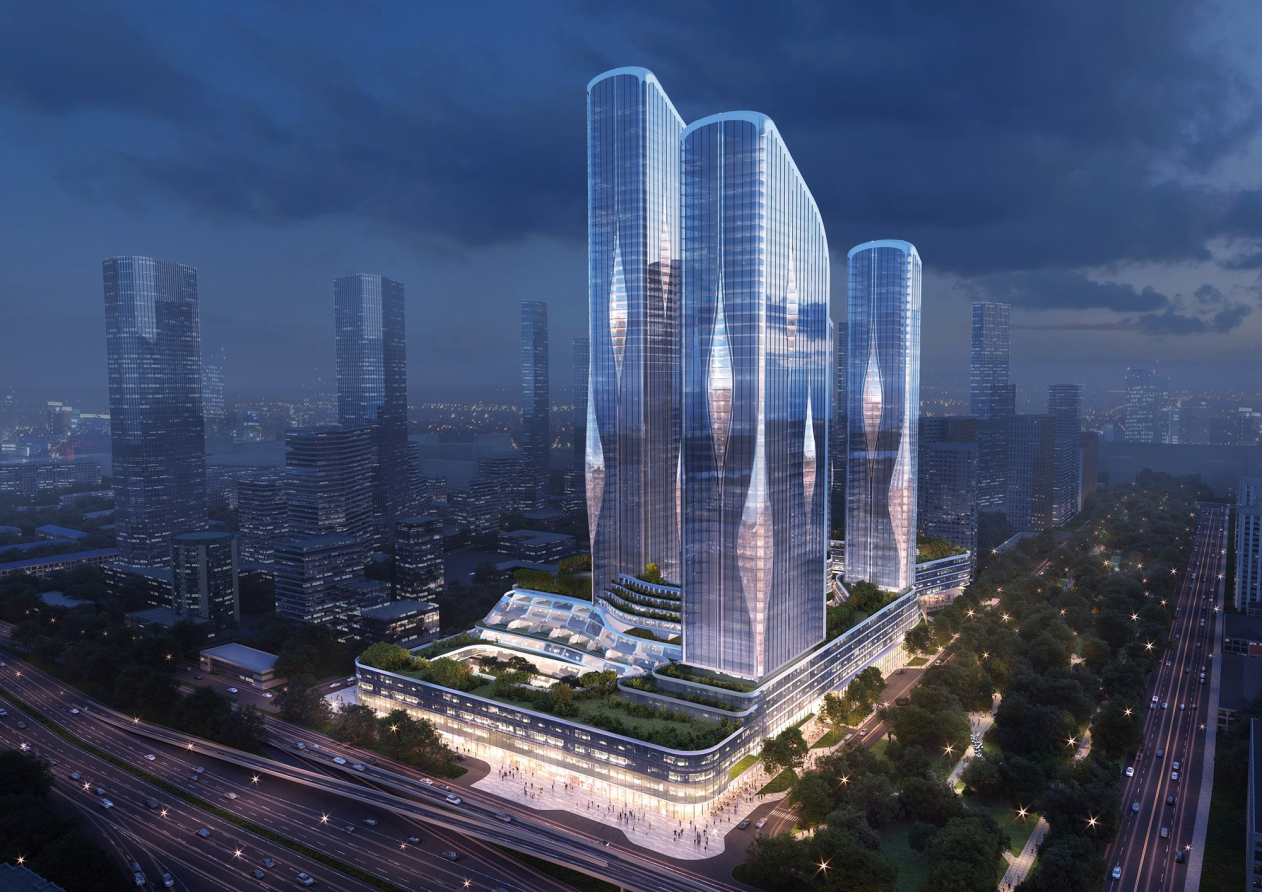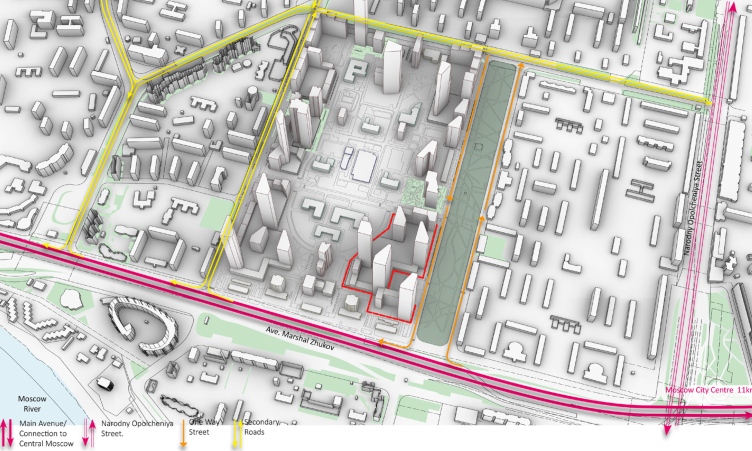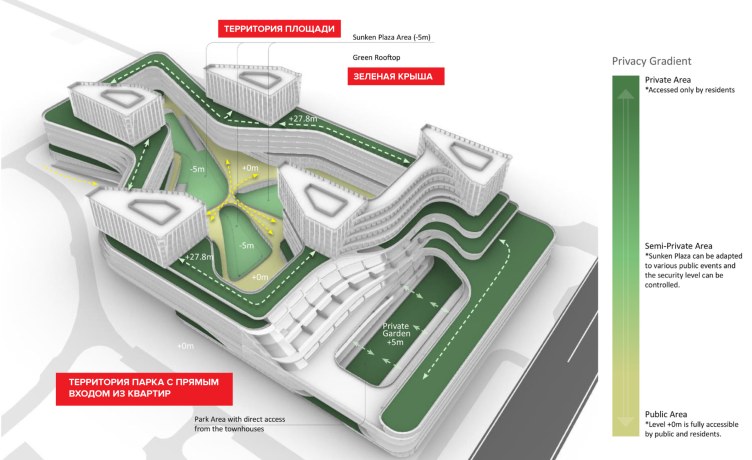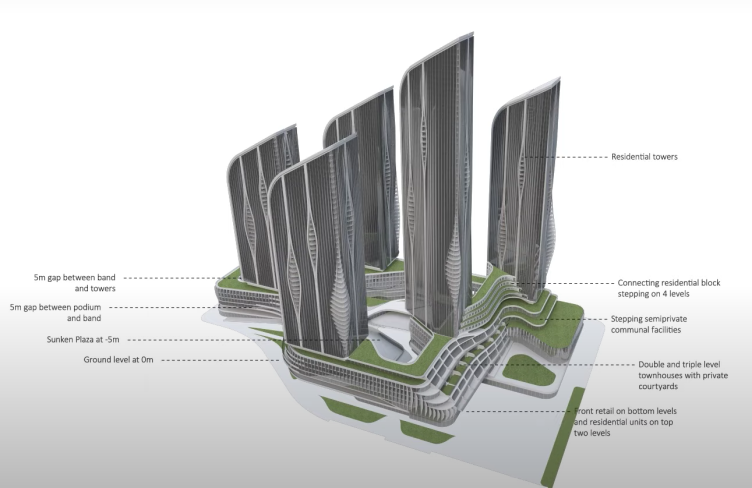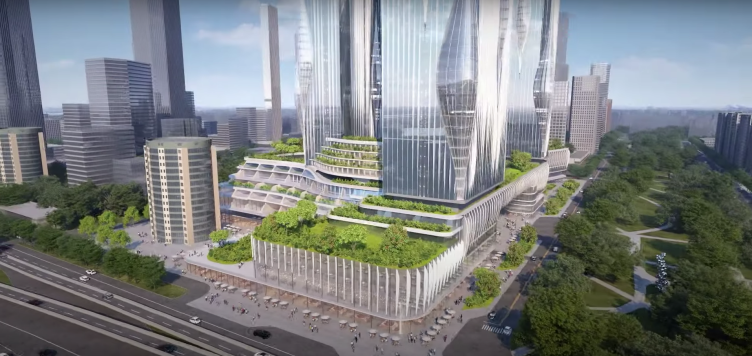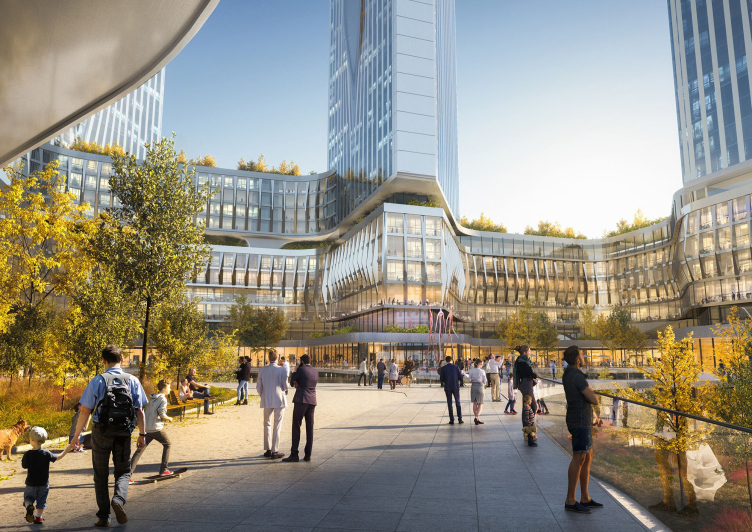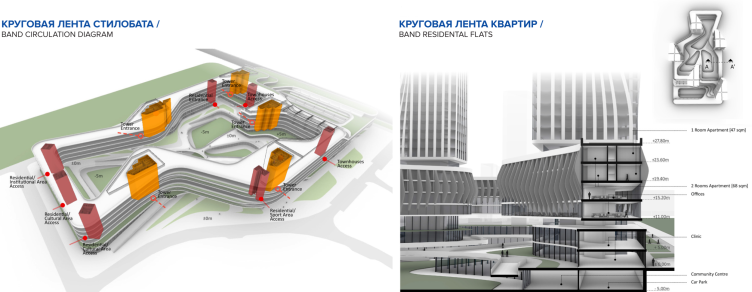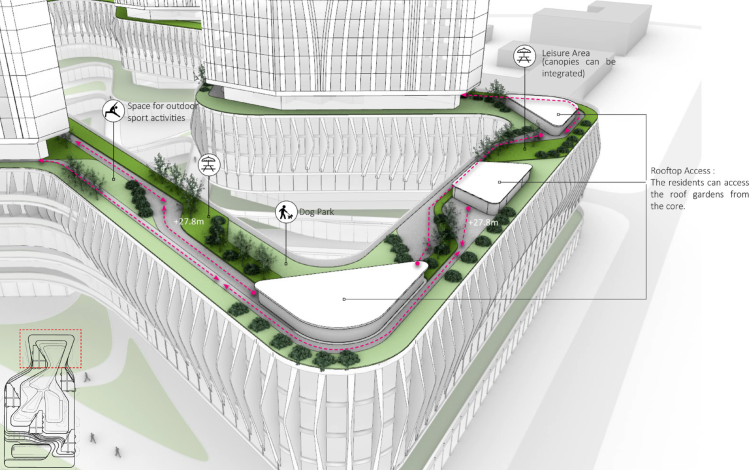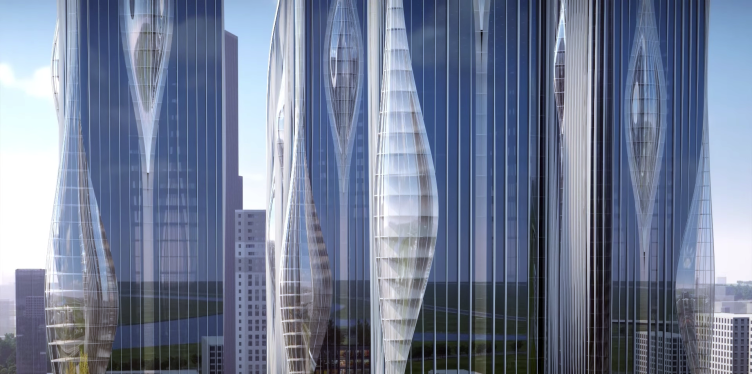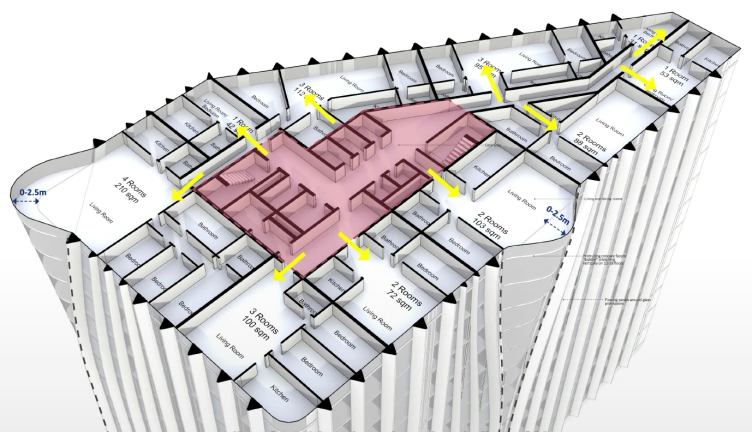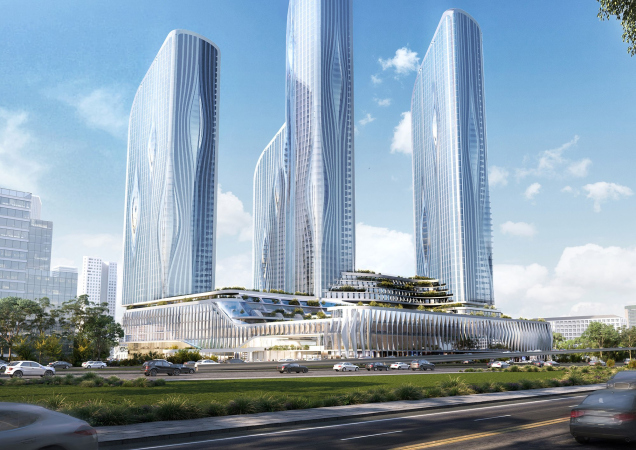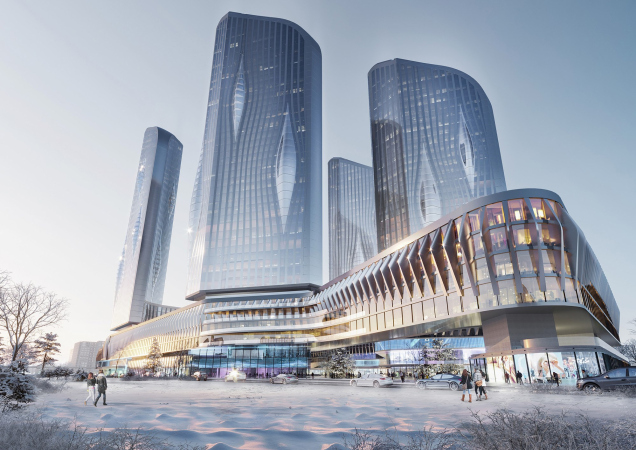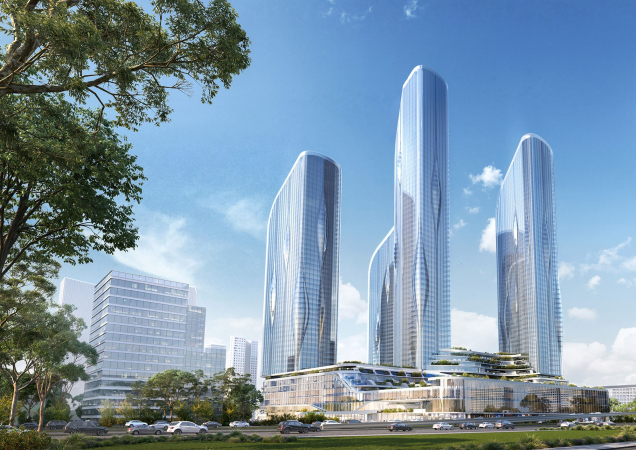Union Towers, a concept, 2021
Copyright: © Zaha Hadid architects / provided by KROST
The site of Union Park occupied the southeast corner of Quarter 82 of Khoroshevo-Mnevniki, with which KROST has been working for quite a while, probably since the beginning of the 2000s. In the mid-2000s, the northeast corner of the quarter got a house designed by Buromoscow, and quite recently the eastern border of the territory got two high-rise buildings of the Union Park, designed by the architectural division of the company, called A.Project. Across from it, in the western part, this same company designed the high-rise housing complex Crystal, which is now in construction, with a few more high-rise volumes in the making.
The location plan within Quarter 82. Union Towers, a concept, 2021
Copyright: © Zaha Hadid architects / provided by KROST
The complex, designed by ZHA, faces the Zhukova Avenue – when it is complete, it will be quite the landmark that will represent the block to the city, engaging in a dialogue with another high-rise housing complex – Wellton Towers (also designed by A.Project), which KROST is currently building on the opposite end of the avenue, on the northwest corner of Quarter 75 of Khoroshevo-Mnevniki, known as Wellton Park.
The map of Khoroshevo-Mnevniki. Union Towers, a concept, 2021
Copyright: © Zaha Hadid architects / provided by KROST
The height of one of the three Wellton Towers is 175m, the maximum height of Union Towers is 300m.
The area of the Union Towers land site is 3.8 hectares. It is “circled” by multilevel stylobate of a sophisticated flowing shape. The stylobate meets the avenue with the lowered part of a shopping and entertainment center, 3 and 4 stories high. Further into the depth of the site, the stylobate begins to grow – sometimes it looks like the deckhouse of an ocean liner, and sometimes it resembles geological layers of weathered rock. The similarity with the latter is enhanced by the green roof that is used in the project at different levels. According to the architects, the total area of the park on the roof will be about 2,000 square meters.
The concept of a landscape park. Union Towers, a concept, 2021
Copyright: © Zaha Hadid architects / provided by KROST
In the central part of the complex, the stylobate grows up to 7, and at places even up to 11 floors. It is expected that it will host numerous functions: retail, offices and coworking spaces, as well as housing, and, according to Christos Passos, of the affordable kind. The offices will also be rented out at reasonable prices. The commercial, i.e. rental premises will account for about one third of the whole amount – 86,000 square meters versus 184,000 square meters of housing space. The project is also expected to generate some 2,000 workplaces.
The upper tiers of the stylobate facing the avenue, yet still remote enough from it, will host 2 and 3-level townhouses with their own little gardens on the terraces. It is these townhouses that look like deckhouses from a distance.
The multifunctional vertical city. Union Towers, a concept, 2021
Copyright: © Zaha Hadid architects / provided by KROST
Union Towers, a concept, 2021
Copyright: © Zaha Hadid architects / provided by KROST
Union Towers, a concept, 2021
Copyright: © Zaha Hadid architects / provided by KROST
Union Towers, a concept, 2021
Copyright: © Zaha Hadid architects / provided by KROST
All of this is meant to ensure a large number of various functions, turning, as the architects put it, the complex into a new center of gravity and making it a part of a multi-centric city.
Working with ZahaHadid Architects is a great responsibility, and the experience gained over the 30 years of KROST development operation will help us in the implementation of this joint project. We have created a scientific and industrial complex and laboratories, which have over a hundred patents. Today we are ready to apply all our knowledge and industrial capacities to implement a multifunctional cluster in Moscow according to the ZHA concept, which will create a fundamentally new environment for life, using the 15-minute city model, as well as modern technological developments where not a single square meter goes to waste.
As for the stylobate, the architects interpret it as a “ribbon” that binds not just the towers but also a lot of functions into a single whole. Among other things, one will be able to walk on the roofs, crossing from one tower to another.
Union Towers, a concept, 2021
Copyright: © Zaha Hadid architects / provided by KROST
The stylobate is streaming around a spacious inner yard – paying respect to its sizes and areas. It is expected that the yard will be open to the city; you will be able to freely enter it from different sides. The architects also designed a few plazas below the zero elevation. The residents’ semi-private yards are situated on the green roofs of the stylobate.
Union Towers, a concept, 2021
Copyright: © Zaha Hadid architects / provided by KROST
Union Towers, a concept, 2021
Copyright: © Zaha Hadid architects / provided by KROST
The circular ribbon of the stylobate / the circular ribbon of the apartments. Union Towers, a concept, 2021
Copyright: © Zaha Hadid architects / provided by KROST
The five main towers are residential ones. They are designed in the style of flowing streamlined forms, characteristic of ZHA, and, according to the architects, imply using the cutting-edge glazing technologies. First of all, such glass will be required for making the bay windows that from a distance look like bubbles, and from the inside provide the best panoramic glazing for the living rooms.
The parks at different levels. Union Towers, a concept, 2021
Copyright: © Zaha Hadid architects / provided by KROST
Union Towers, a concept, 2021
Copyright: © Zaha Hadid architects / provided by KROST
Union Towers, a concept, 2021
Copyright: © Zaha Hadid architects / provided by KROST
All the five towers have a similar texture: the facades are dominated by a grid of thin vertical stripes that from time to time “step aside” to make room for the “bubbles” of the bay windows. The top parts are sharply chamfered away from the avenue and into the depth of the block, which makes the silhouette of the complex almost triangular – hence, we are seeing the tallest towers on the avenue side.
Union Towers, a concept, 2021
Copyright: © Zaha Hadid architects / provided by KROST
The project is scheduled to be completed in 2028.
Union Towers, a concept, 2021
Copyright: © Zaha Hadid architects / provided by KROST

